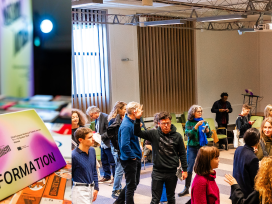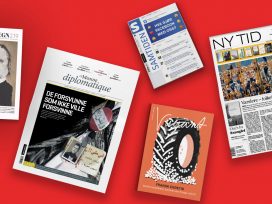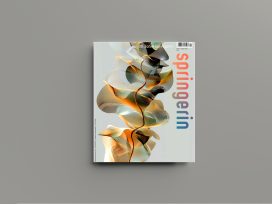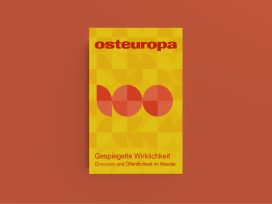Within the field of cultural journals, our research found they emphasize three qualities: a clear mission, an important function, and a special format. The journals’ editorial boards have a publicists’ objective: they have something they are passionate about and want to communicate. Furthermore, the journals often serve as a type of nesting ground or ‘nursery’ for new voices on the cultural scene. They can also be said to work as a mirror that reflects the zeitgeist, and they are important, not least because they raise the big issues of the times and subject them to thorough and serious discussion. This gives them an additional archival function that makes them useful for the future. Finally, the field attaches importance to a thoroughgoing format in which the practice of critique and the essay as a genre play key roles.
Norway has a well-established support scheme for cultural journals. The Arts Council Norway, a public agency governed by the Ministry of Culture, annually distributes a NOK 10 million production and purchasing support budget to safeguard their existence. In addition, millions are distributed through other support schemes managed by the Arts Council Norway and the Norwegian Film Institute, another government agency governed by the Ministry of Culture. According to the guidelines for awarding these funds, support may be granted to ‘Norwegian periodicals, whether published in print or online (or a combination of the two) that wish to reach a general audience with information and reflections concerning issues relating to culture and society, or that explain and analyse the arts and the cultural heritage sector (Arts Council Norway 2015)’. The Arts Council clearly groups cultural journals into two different categories. We have chosen to refer to these categories as ‘political’ journals (approximately 40 per cent) and ‘arts’ journals (approximately 60 per cent). ‘Scientific’ journals are, however, covered by a different support scheme and were not included in our survey.
Our survey included all periodicals that had applied for funding under these schemes on the premise of being a ‘cultural journal’. We presumed that those who believe they satisfy the requirements for funding can be considered cultural journals and deem this to be a practical operationalization.
We identified a total of 130 cultural journals. To survey and analyse them, we carried out a number of sub-studies. The first involved a questionnaire addressed to the editors of all the journals (response rate 64 percent). We then proceeded to carry out qualitative interviews with key readers of three periodicals: Samtiden (In our Time), kunstkritikk.no (Arts Critique), and Norsk Shakespeare- og teatertidsskrift (Norwegian Journal of Shakespeare and Theatre). Finally, we conducted content analyses of articles published in 117 journals. We also conducted a few supplementary interviews and carried out more in-depth content analyses of four selected journals and the culture pages of two newspapers.
A weak field under pressure
Our analysis is based on the premise that all fields are embedded in other fields, so that any change in adjacent fields will affect and influence the field in question. There are no strong institutions or organizations in the field of cultural journals that are poised to advocate their cause and secure their interests. The most important organization is, however, Norsk Tidsskriftforening (The Norwegian Organization of Cultural Journals) which has a yearly budget below one million NOK, partly financed by the Arts Council. In the terminology of Fligstein and McAdam, this is a highly ‘dependant’ field. Nevertheless, it is able to maintain a certain autonomy by insisting on making do without money, and by virtue of the fact that the actors reject ‘ordinary’ criteria of success in other fields, such as profitability and/or a large readership.
Consequently, the field of cultural journals represents what Pierre Bourdieu refers to as the ‘economic world reversed’. The journals are important to the publishers who, despite the marginality of the field, think cultural journals have an important social role. This is why they are published and why they are important.
Our analysis shows that, in the course of the last 25 years, the field of cultural journals has experienced major external upheavals. First, the world of academia has introduced new ways of assessing merit. These days, the most important criteria for academic employment, promotion, and wage increases is publication in international peer-reviewed academic journals. We see from our data that the percentage of contributions to cultural journals from academia has fallen considerably. This trend is confirmed by our informants among editors and other actors in this and adjacent fields: there are fewer topical articles penned by scholars available. Our data suggests that they are being replaced by writers who find themselves in, or in the periphery of the field of news journalism. This is particularly the case for the political journals.
Mission
Matthew Philpotts makes a distinction between ‘charismatic’ and ‘institutional’ editorships. This conceptualization may be related to a distinction between the cultural journals as publications with two missions. One is meant to influence society or the art-world by steering the readership in a particular direction. The other serves as a platform or a channel for the contributions of others and diverse views on aspects of their specific field and society at large. We have studied the completed questionnaires and what they say about the journals’ agendas. The responses suggest that many editors have a specific mission beyond that of creating an arena for other people’s text production.
The journal editors are acutely aware of readers’ potential significance as opinion leaders. We found several examples of editors who think their journal influences the current social debate through its readership.
The editors also wish to make space for new voices by being the first to publish and/or comment on the ‘new Knausgård’. The responses to our survey’s open question suggest that this is important to many.
The third type of mission is more political, relating to arts policy. Many editors wish to shape how journals interact with the general public and participate in general public debate. Some editors seek to muster support for a particular standpoint. This may be a special view on the arts, which many think is the case with Kunstkritikk.no and Norsk Shakespeare- og teatertidsskrift(NST). Others wish to steer political debate in a specific direction by, for example, directing attention to issues like climate change.
Our literature and case studies further indicate that readers generally consider journals with a clear publishing profile to be the most important, most interesting, and most relevant. In other words, the ‘charismatic’ editors appear to achieve a higher ranking in the field’s internal hierarchy.
At the same time, the cultural field is becoming increasingly differentiated and, according to informants, some subfields grow, increase demand, and create a market for more specialized websites. Some of the editors of these websites simply do not want to reach a broad audience. They will rather be an arena for professional development and debate among niche experts. Our survey suggests that it may be appropriate to approach the issue from the angle that the niche experts help to increase the relevance and significance of the highly specialized journals for those concerned.
Function
Writing history as it unfolds is difficult. However, some of our data support the conclusion that they work as a ‘mirror of the times’ and a manifestation of the ‘zeitgeist’.
Some of our informants in the qualitative case studies of Kunstkritikk and NST clearly state that the journals specifically have an ‘archival function’. They point to the long lives of the two periodicals, i.e. that their articles are felt to be relevant and interesting for a long time after publication. This durability may suggest that, through their clearly filtered and prioritized selection of texts, the publications provide a unifying documentation of key trends, debates, and actors within their respective circles. This may, in turn, be due to the fact that the journals are normally explicitly edited in line with an overarching idea, either to promote a particular view or to reflect on key discussions in specific public sub-spheres.
Another indication that the journals fulfil this function is mentioned above. A large number of responses to the survey of editors point to a wish to promote and develop new voices. This is why the journals give space to new and unknown artists, writers, and critics. These new voices sometimes formulate the era’s response to ancient questions. They try ‘to contest the old, the dead, the obsolete in order to present the issues of today, the topical, the new and relevant ideas’ as Sissel Furuseth, Jahn Thon and Eirik Vassenden say in their work on Norwegian literary journals.
Our content analyses of 117 cultural journals also shows that the material printed in journals is neither generally news-oriented nor of a journalistic nature. Furthermore, the journals do not predominantly consist of interviews, but articles, essays, and in-depth critiques for which the authors are accountable for all thoughts and analyses. Considering that most journals publish only a few issues per year, and subject their content to a relatively thorough editorial process, this may be interpreted to mean that the journals’ content is well thought-out and edited. Furthermore, it may support a conclusion that while the daily media provide ‘the first rough draft of history’, the journals still provide the ‘zeitgeist archive’.
Format
Our survey shows that the journals are not generally news-oriented or journalistic in style. Although a growing percentage of their contributors earn their living from writing, the journals do not generally feature journalistic content such as interviews, reportage, or consumer advice. Approximately 70 per cent of the material published in journals does not contain interviews. The overwhelming majority of the journals are published only a few times a year and they update their websites less frequently than once a week. This means that they need to focus on material other than news. On the other hand, our survey shows that digitalization has contributed to making certain journals more news-oriented and concerned with topicality, which is a characteristic of journalism. However, this mainly applies to journals that are published online only. Print journals and journals with both print and online editions are clearly distinct from newspapers. Besides, online journals are considerably less news-oriented than the daily press.
Cultural journals wish to reach their audience with texts that may well discuss challenging and complicated phenomena, but they also need to be well written and presented. They stress that quality assurance is important to them, and that they strive to improve commissioned and submitted material. According to our case study informants, the journals’ value is associated with specific format-related qualities such as the writers’ level of knowledge, the thoroughgoing quality of the texts, and the editor’s or editing department’s stance as a publisher. Some point to ‘a format heavy with references combined with being clearly aimed at a general audience’ as a quality specific to the material published in journals.
Finances
Our data also suggest that editors, who have their budget increased, tend to spend the extra money on higher fees to their contributors rather than on paying themselves. Earlier reports have, however, shown that the journals’ finances have always been very poor. Our survey of editors shows that this is still the case, and that the financial situation has probably worsened in recent years, generally because costs have increased. One example is postage, the cost of which has dramatically increased in recent years. Some respondents document a sevenfold increase in the cost of postage since the year 2000. For the first time in history, journals are paying more for distribution than for printing. Despite their weak – sometimes terrible – finances, the editors feel that they are still able to maintain the quality standards when it comes to content. Significant amounts of voluntary work is among the factors that so far have secured the qualitative output of journals, combined with considerable assistance and support received from owners, the Arts Council Norway, and others. Were it not for this type of assistance, many would not survive.
Some of our informants point out that the publishing houses that own several key cultural journals are undergoing developments that will take them in an increasingly commercial direction. They have sharpened their focus on bestsellers for the widest possible markets. One example is the publication of Fifty Shades of Grey by Norway’s largest cultural heavyweight, Gyldendal. Another is Cappelen Damm spending NOK five million on securing the rights to Calendar Girls.
Many believe that the publishing houses will be moving increasingly further into the part of the field that Bourdieu calls ‘large-scale production’ , moving away from the ‘restricted production’ area occupied by the journals. This may cause the publishing houses to reduce or discontinue their subsidy payments to journals.
Many see Cappelen Damm’s 2016 decision to wind up its stake in the acclaimed and important literary journal Vagant as a part of this trend. Our survey suggests that considerable support from parent publishing houses is essential to safeguard the publishing of some of Norway’s foremost cultural journals, such as Vinduet (The Window), Samtiden, and Kunst og Kultur (Arts and Culture). It is a widespread view in the field that the large, commercial publishing houses have had an implicit, mutual understanding that each of them take responsibility for their own cultural journal. This understanding has helped to maintain a collective behavioural pattern among the publishing houses. This may demonstrate weak resistance to non-conformity. According to Granovetter, breaking a behavioural pattern may initiate a chain reaction that brings about the collapse of the entire pattern of interactions. Many fear that other publishing houses, who have been the most important life-sustaining sponsors for the field’s most stable actors, will follow Cappelen Damm and withdraw their support.
Digitalization
Our survey shows that the journals so far have approached digitalization with great calm. However, some underlying trends may well bring about a change.
It can be argued that journals form part of traditional mass communication to only a limited extent. With a few exceptions, these publications have a very low number of subscribers and a small readership and have no wish to ‘reach everybody’ in the same way as conventional journalism. This may mean that personal communication is a more serious competitor, or a more important alternative, to journals than the mass media.
In turn, this means that the emergence of social media may play an important role. Admittedly, social media is not a new thing. Letters, for instance, have played a significant role in interpersonal communication, particularly among readers. 19th century authors often wrote many letters. There is every reason to believe that the letter-writers exchanged cuttings from newspapers and journals through their letters, even across borders. This way, early periodicals gained access to material. Clearly, mediated one-to-one communication did not arise with the birth of social media, but digitalization has made the process far more efficient and has greatly extended its scope.
In our view, ‘communication’ does not qualify as a separate field in our definition of the term. But social media form a part of the communication systems within and in between fields and are thus in a position to change them. Fligstein and McAdam point out that improvement in communication technology influence the actors’ relationships with one another, thereby working as an important driver for the formation of fields as well as changes within fields.
In the field of cultural journals, digitalization has rationalized and increased the level of direct contact among the journals’ readership. One of our findings is that the flow of texts on social media has an impact on the role played by the journals. Firstly, the journals make use of social media to distribute or promote articles. As much as 96 per cent of the journals make use of social media such as Facebook to raise their profile.
Secondly, ‘personalized digital networks’ are formed. Social media provides readers with broad access to articles published in the languages they can read. This gives potential readers of journals access to a larger and more international network that, in part, replaces the role of the conduit that the journals used to have.
The combination of users’ social networks and journals’ distribution of their own articles offers a considerable range of relevant, free information that competes for the individual user’s time.
For instance, the case study informants pointed out that they stay up-to-date with the international visual arts scene through the internet, while they depend on a Norwegian online journal, Kunstkritikk, to keep themselves informed about national trends. On the other hand, the respndents who were asked to describe the function of Samtiden considered the Facebook flow to be a direct competitor to the journal. More than half the respondents to the editor survey reported that digitalization sharpens the competition.
As a consequence, the journal editor’s role as a gatekeeper has been weakened. Today, any writer who has been rejected by a journal can instead post their text on their own Facebook page or blog.
Digitalization may, therefore, weaken the influence of journals, but we do not know whether this is a lasting trend. Many maintain that unlimited access to digital information will create a demand for selection and editorship. Some may prefer the selection of information to be made by people they trust, such as the editor of a journal, rather than a computer algorithm whose workings are inaccessible to them. If the journals are to maintain their position in the media, it will be essential that they retain the qualities that have, so far, defined them as a field in its own right.
Some of our data may suggest that digital publishing platforms challenge the journals’ traditional choice of genres. The genre-composition of online journals is slightly different to that of print journals. Their publishing frequency is different, too. Our comparative analysis of the printed and online versions of two journals, Ballade (Ballad) and Minerva, may suggest that the transition to online publishing has a greater impact on the choice of genres than the transition from online journal to online newspaper. When Minervawas a print journal in 2005, nine per cent of its material was journalistic. After the transition to online publishing in 2016, this percentage increased to 37, and when it launched an online newspaper the following year, the proportion of journalistic material rose to 48 per cent. Nevertheless, the differences are far greater if we look at the printed and online versions of the journal Ballade. This conforms with a general trend shown in our content analysis of the entire journal population: the online versions of dual-format journals retain the content-related character of the print journal to a much greater extent than journals that are solely published online.
Another finding of our analysis is that a certain proportion of the periodicals that receive support as such from Arts Council Norway are, in fact, not journals according to our definition. Their function is, by and large, that of a news channel, and their objective is primarily to maintain what someone refers to as a ‘group communication functionality’. They do this by taking on a role similar to that of a ‘local newspaper’ for the field of the arts in which they are embedded. This applies particularly to new arts journals that are published online from the outset. Our data shows that many of the editors of new publications have a different sense of self-awareness to the editors of the established print and dual-format journals. This opposing view is related to the pressure for constant updates that is integral to the online journal format, but it is likely also to be associated with the poor organization of the field of journals. A lack of access barriers to the field, and a scarcity of venues for the sector’s actors to meet, probably contribute to newcomers entering the field with competing views on what a journal is. And it is unlikely that they will be introduced to the views traditionally held within the field through social interaction.
In other words, there are signs to suggest that the influence from the far better organized journalistic news sector has a greater impact on online journals than on print journals. One possible implication may be that the print format retains an important function in maintaining the journals’ special characteristics vis-à-vis other periodicals. Our findings suggest that the journals are still able to defend their special character and, therefore, their dedicated place in the cultural eco-system. However, there are potential threats to their position.








